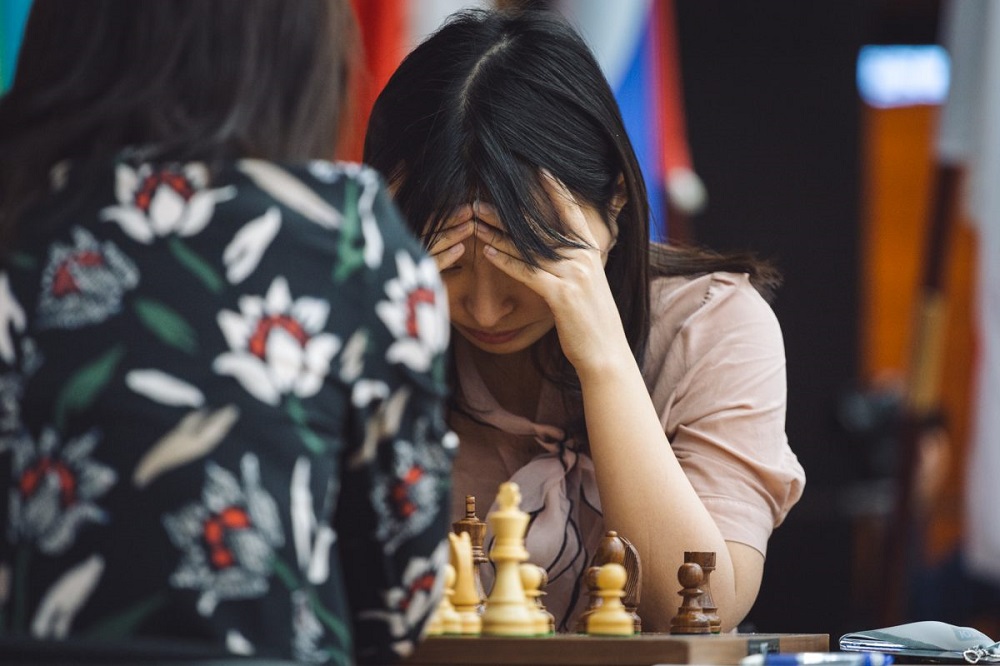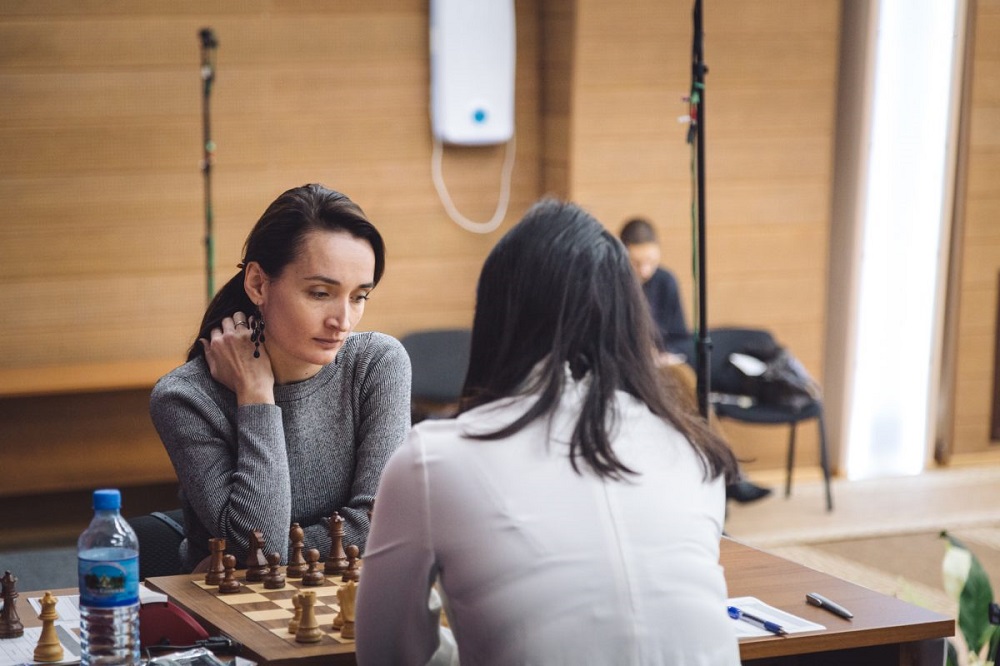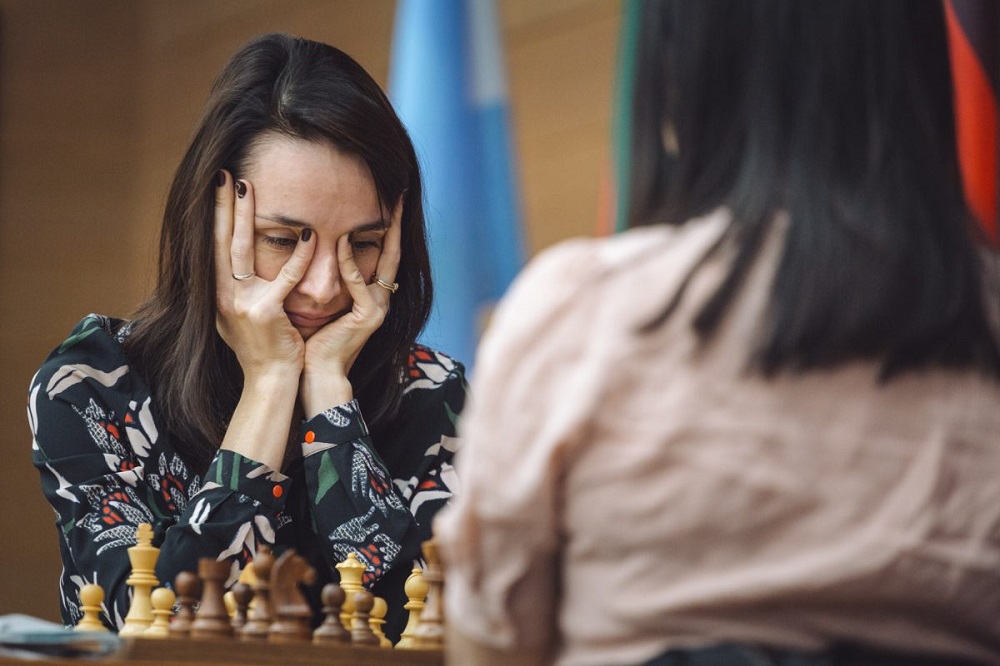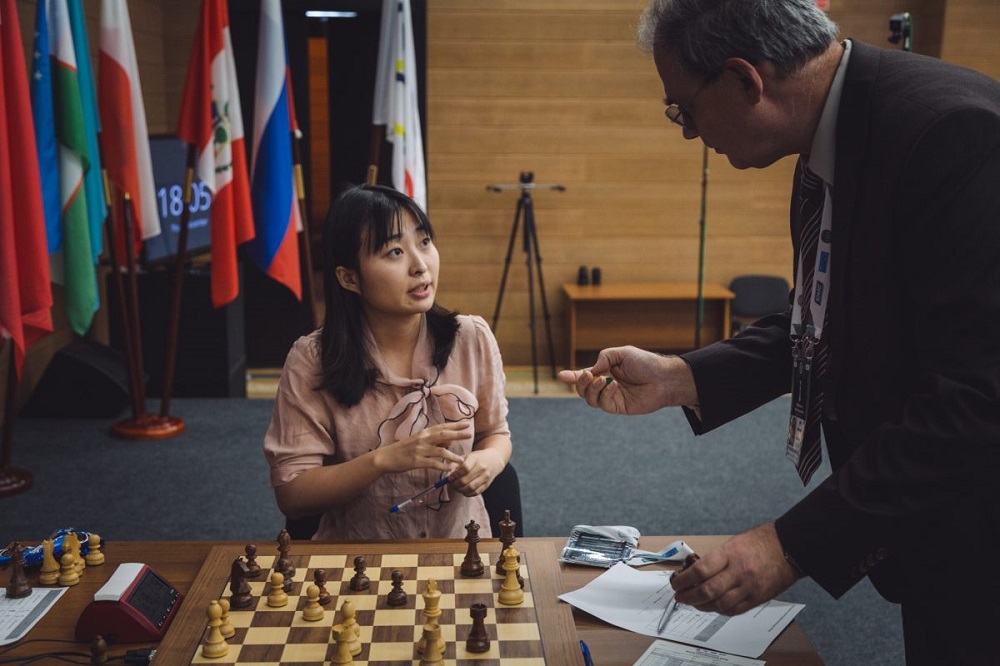


An undefeated Ju Wenjun had arrived in the final as the slight rating favourite, but most importantly with the advantage of having had more rest days than her opponent. However, it must be said that Kateryna Lagno was also undefeated in classical games, as her only loss came in a blitz game against Natalija Pogonina. Two very deserving finalists were about to battle in the most important duel between women in the world.
Lagno was the one who had the upper hand on game one, and she finally managed to break the Chinese's defences in the next encounter. This was the first time that Ju Wenjun found herself on the ropes in the whole tournament — would she be able to step up from behind?
She certainly did!

Getting ready to hit back...
With Black, Lagno went for a King's Indian Defence in game three. Ju developed her pieces quickly, gave up a pawn and even offered an exchange sacrifice in the early middlegame. With her pieces much better placed, the computer showed some lines that might have given Ju a larger advantage. Certainly, recovering a pawn instead of keeping the initiative is a decision she probably regretted later on:
The World Champion could have kept pressing by occupying the open c-file and trying to get something on the dark squares, but instead captured with 35.Qxe5 — and, of course, Lagno went into the endgame with 35...Qxe5 36.Bxe5 Kf7.
It is true that White still had better chances in the ensuing position, but we have recently seen that is tough, even for World Champions (Carlsen had a similar edge on his match in London), to convert an advantage in endgames with opposite-coloured bishops, in spite of the presence of rooks on the board — without them, it tends to be even harder!
In the end, the draw was signed on move 68.

Lagno drew and was still half a point away from the title
Although game one was a failed attempt, Ju Wenjun showed great fighting spirit...and she came back for more!
Game four saw Lagno choosing the Rossolimo variation against the Sicilian, the same weapon used with little to no success by Fabiano Caruana in the first three games of the match against Carlsen — a bad omen for the Russian. Nonetheless, what apparently caught her by surprise was Ju's fifth move, 5...e5, after which Kateryna thought for almost twelve minutes before responding 6.a3.

Kateryna took long thinks in the opening
What followed saw Ju Wenjun keeping most pieces on the board (only one pawn was exchanged before move 20) and getting the kind of complicated position that one wishes for while in a must-win situation. Already down on the clock and with all the pressure on her shoulders, Lagno erred on move 19:
Lagno needed to close the centre with 19.c4 or shelter her king with 19.Kh1, but went for the tactical 19.Nh4? instead. The computers were screaming for 19...c4 for Ju, when after 20.Nxg6 Bxd5, the a8-h1 diagonal is open for Black to later get a strong direct attack. Black's 19...Bh8 did not completely give away the advantage but surely allowed White to regroup a bit.
Eight moves later, the computer evaluated the position with a stone-cold 0.00, but Black still had both rooks and the queen lined-up on the g-file:
Lagno quickly played the 'automatic' 28.Kh1?, which turned out to be the losing blunder — she needed to find 28.Qh5, not placing her king in the long diagonal and keeping the tension.
Ju Wenjun did not take long before responding with the lethal 28...Bc8, threatening to put her bishop on said diagonal. Now 29.Qh5 came too late, as it created a mate-in-ten position for White. The game was over after 29...Bb7+ 30.Kg1 Rxg3+! 31.hxg3 Rxg3+ 32.Kf2 Rg2+:

The game is over and Ju Wenjun might still keep her crown
After seeing this outcome, study expert Siegfried Hornecker sent an observation that hit the mark. It refers to the Lasker vs. Shlechter 1910 World Championship match, when Schlechter — the Challenger, like Lagno — was up one game before the last encounter and was not able to find the correct continuation to take the title from Lasker's hands. Hornecker writes:
Of course, if on that 9 February, 108 years ago, one 35 year old man from Austria-Hungary would have played 35...Rd8, or even 39...Qh4+, chess history would have taken a different turn.
Lagno today had her chance in 28.Qh5. But she misjudged, just as Schlechter did. But unlike him, she will get a chance again tomorrow, or — if Ju doesn't grant a chance — in the next cycle. Carl Schlechter never got that chance again...
Annotation taken from chessgames.com
It is curious that another Challenger, Fabiano Caruana, also missed a chance to keep the pressure on the Champion by playing the timid 24.h3 instead of — yes, the same move — 24.Qh5! just two days before...
But, as Siegfried correctly points out, Lagno, unlike Schlechter, will have a chance to win the title on tiebreaks. A highly entertaining tournament with an exciting final match is about to crown its champion. There is no reason to miss it.

The stage is ready for the final showdown
Select an item from the playlist to replay commentary from prior rounds